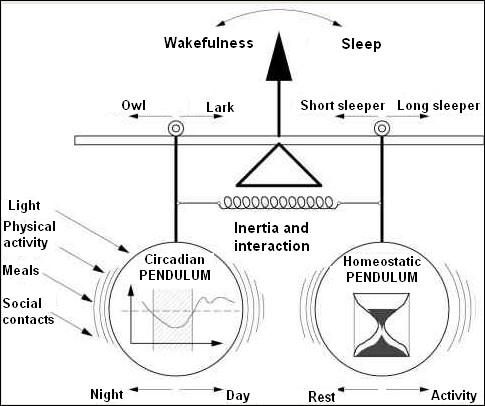Home > Welcome > Sleep-wake pathologies > Chronobiology - have to sleep > Modelization of the pendulums of sleep
Modelization of the pendulums of sleep
"The electric light screwed the whole thing up" Pr Michel Jouvet (2004 - UTS)
Wednesday 8 August 2007
All the versions of this article: [English] [français]
This animation helps to understand the fragility of the sleep regulation system, and the different parameters that have to be taken into account to be able to sleep.
(The system runs with Flash Player 9.
If you cannot see the animation, clic here to access to the free downloads of Adobe).
The balance of sleep obeys to a system of double pendulum.
- the Circadian Pendulum (de circa dia : around a day), modulates the pressure of sleep according to what time it is on the internal Clock.
- the Homeostatic Pendulum depends of the individual need for sleep on one hand and of the external constraints on the other hand.
At normal state, wake and sleep follow each other according to a rythm in harmony with the day and night cycle.
For more explanations about the "Double Pendulum" see the: Mechanisms of sleep regulation"
Act on the cursors to modify the balance of the system. The system works fine with Flash Player 9)
The chaotic movement obtained after a change in the period of one of the pendulums is similar to the states of internal dissociation encountered in subjects who suffer from not being able to adapt to shift work (and, et, as we have learned recently, general anaesthesia).
The "internal dissociation" expresses through a complaint of tiredness and/or sleepiness.
Many functional disorders encountered in general medicine might be rooted in chronobiological disturbances of that kind. (See the "hypo-sleep syndrome").
|
1. On the left side of the figure, the CIRCADIAN pendulum which behaves like a true internal clock which would open (and close again) the "gates of sleep" at some propitious moments of the nycthemeron (the "24 hours of the day"). The cyclic variation of the body temperature is its main marker. Cut from all sorts of external time signals, (Cf. phototherapy), that clock remains set on 24 hours. 3. External "time givers" : (light, heat, food and social contacts) act to synchronize sleep on the day and night alternation.
|
2. On the right side of the figure, the HOMEOSTATIC pendulum can be compared to a simple hourglass which is turned upside down after some time of sleep or wake accumulation (based on a period of 24 hours in normal conditions). In the adaptative equilibrium zone of that pendulum, the duration of each period (of wake or sleep) is proportional to that of the preceding. The pressure of sleep depends of the duration of the preceding wake and inversely. 4. The force of the interactions between the two pendulums and the inertia of the whole system determines the ability to adapt to irregular sleep schedules. |

- Double pendulum model for the regulation of sleep/wake rythms
